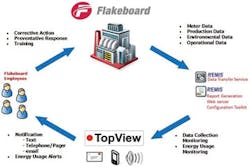Flakeboard Co. Ltd. recently implemented a long-term energy-savings program, including an audit and use of energy management software for real-time monitoring.As a result, Flakeboard says it has saved $260,000 in a 12-month period and continues to find efficiencies.
The company was recently recognized for its efforts at the biennial Energy Conference co-hosted by Natural Resources Canada. At the conference, the Canadian Industry Program for Energy Conservation (CIPEC) honored Flakeboard with the CIPEC Leadership Award for making a significant and innovative contribution to energy efficiency in the monitoring and targeting category.
Flakeboard Co. produces quality composite-wood panels. Using lumber industry by-products and under-utilized wood species — formerly landfilled or burned as waste by forestry operators or sawmills — the company manufactures particleboard varieties, medium-density fiberboard (MDF) and FIBREX, a thin high-density MDF.
Flakeboard needed better energy-cost analysis and allocation for its mills. The responsibilities of Pat Burke, electrical systems coordinator, included energy management for the entire corporation. “We knew how much we were spending on energy overall, but it was deemed important to be able to understand cost per unit through the breakdown of the energy used by each of the mill’s production lines,” says Burke.
The long-term energy-savings program included an energy audit, implementation design and energy-management software, including RtEMIS from RtTech Software and Exele TopView for real-time monitoring and notification.
Audit and Implementation
The Energy Management Information System (EMIS) audit determined the potential energy savings and estimated the funds required to implement a full EMIS. It revealed that $1 million in energy savings could be achieved over a three-year evaluation period. As you would imagine, this was a key factor in getting management approval to move forward.
Based on the gathered data, an EMIS implementation plan was developed. Its execution established baseline data, selected appropriate meters for usage-data acquisition and specified software for monitoring and employee training programs.
Flakeboard’s EMIS used energy account centers (EACs). Each of 120 Flakeboard energy account centers (EAC) monitor electricity, oil, water and compressed-air use in production processes at each mill’s processing and finishing lines where meaningful energy use is concentrated.
At the St. Stephen site, for example, 40 electrical meters were added, as well as meters for oil, gas, water and compressed air. Energy data is combined with production rates, temperatures, and other system variables to calculate energy-account performance.
Data Analysis and Reporting
RtEMIS from RtTech Software displays targets and performance for each of the mill’s EACs in near real-time, as day-to-day energy consumption and the percentage of the target reached as well as the cost and cumulative savings.
“One major factor in choosing the RtEMIS system over others is its ability to monitor input data,” Burke says. “Other systems could go ‘flatline’ for hours or days without anyone ever knowing that they stopped tracking usage.”
RtEMIS incorporates EXELE TopView, a data monitoring and notification software package capable of monitoring the data flow from all the various meters and other sources. TopView interfaces directly with the energy and process data and notifies the appropriate personnel if it detects any abnormalities, such as a non-functioning meter.
TopView also handles reporting functions. Each morning the system automatically sends a status report on all communication devices. Each HMI screen and appropriate facility managers receive messages when a process has exceeded its preset threshold. Messages are also emailed to the appropriate managers.
Beneficent Results
The software points out when fans, compressed air or lighting are left on when production isn’t running. The staff is more aware of potential energy savings, and work habits have changed.
Each production line now has energy target levels set for levels from full to idle to zero, with usage measured against these targets. Peak-level status reports for each account center illustrate energy reductions and invite lower targets to be set as saving are realized.
In a recent announcement congratulating Pat Burke for his efforts, which have brought bought savings and recognition to Flakeboard, President Kelly Sholbolt noted he would be looking to Burke to roll out this “valuable tool” across other plants.



